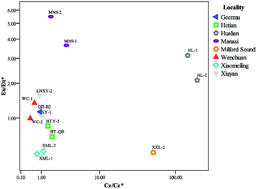Studies of rare earth elements to distinguish nephrite samples from different deposits using direct current glow discharge mass spectrometry
Abstract
Nephrite is an interesting gemstone of wide versatility that is used for ritual objects, decoration, utilitarian objects, carving or jewellery around the world. It is necessary to demonstrate a possible relationship between the concentrations of characteristic elements and differences in the quality or deposit. In this study, direct current glow discharge mass spectrometry (dc-GD-MS) was used to determine the rare earth elements (REEs) of 14 nephrite samples from different deposits by using a tantalum (Ta) pin for the electrical connection, and this method has successfully overcome interferences in the REE analyses. After the optimization of discharge conditions, the characteristics of REEs were studied for nephrite minerals obtained from different deposits. Principal component analysis using REEs and other minor and trace elements successfully separated some nephrites from specific deposits. The dc-GD-MS was an effective tool for the classification of nephrites from different deposits.

- This article is part of the themed collection: Glow Discharge Spectroscopy

 Please wait while we load your content...
Please wait while we load your content...